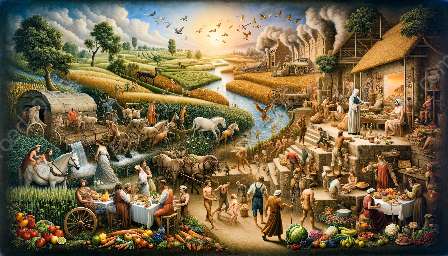Throughout history, the introduction of new crops and food resources has significantly impacted food production, agriculture, and food culture. This cluster will delve into the historical developments in food production and agriculture and how they have shaped the food culture and history we know today.
Historical Developments in Food Production and Agriculture
The history of food production and agriculture is a fascinating journey that spans centuries and civilizations. From the ancient agricultural practices of the early human settlements to the agricultural revolution that transformed farming methods, the innovations in food production have played a crucial role in shaping the world as we know it.
Ancient Agricultural Practices
Early human settlements relied on agriculture for sustenance and survival. The cultivation of crops such as wheat, barley, and rice, and the domestication of animals, laid the foundation for the agricultural practices we use today. The ancient civilizations of Mesopotamia, Egypt, and Indus Valley developed sophisticated irrigation systems, enabling them to cultivate crops on a larger scale and support burgeoning populations.
The Agricultural Revolution
The agricultural revolution marked a significant turning point in food production and agriculture. Innovations such as the invention of the plow, the use of crop rotation, and the introduction of new farming techniques increased agricultural productivity and paved the way for large-scale farming. This led to the growth of urban centers, the rise of trade networks, and the emergence of complex societies.
Impact on Food Culture and History
The introduction of new crops and food resources has not only transformed the way we produce food but has also had a profound impact on food culture and history. New crops brought from distant lands have enriched culinary traditions and diversified the global food landscape, creating a rich tapestry of flavors and culinary techniques.
Global Exchange of Crops
The Age of Exploration facilitated the global exchange of crops, known as the Columbian Exchange, which had a transformative impact on food production and consumption. Staple crops such as maize, potatoes, and tomatoes were introduced to Europe, while crops such as coffee, sugar, and bananas made their way to the Americas. This exchange led to the integration of new ingredients into various cuisines, revolutionizing culinary practices around the world.
The Green Revolution
In the 20th century, the Green Revolution brought about a significant increase in agricultural productivity through the introduction of high-yielding crop varieties, modern farming techniques, and the use of fertilizers and pesticides. This revolution not only boosted food production but also reshaped food culture by influencing dietary habits and global food trade.
Adapting to Changing Food Resources
As the world continues to experience environmental and climatic changes, the necessity to adapt and innovate in food production and agriculture becomes increasingly vital. The development of sustainable farming practices, the exploration of alternative food sources, and the advancement of technology in agriculture are paving the way for a more resilient and diverse food system.
Sustainable Agriculture
Efforts to promote sustainable agriculture aim to minimize the environmental impact of food production while maintaining productivity. Practices such as organic farming, agroforestry, and precision agriculture are gaining traction, offering environmentally friendly alternatives to conventional farming methods.
Alternative Food Sources
The exploration of alternative food sources, such as edible insects, microalgae, and plant-based proteins, presents innovative solutions to address food security and sustainability challenges. These emerging food resources offer nutritional benefits while reducing the ecological footprint of food production.
Technological Advancements
Advancements in technology, such as precision farming tools, drones for agricultural monitoring, and gene editing techniques, are revolutionizing the way we produce food. These technological innovations enable more efficient resource utilization, improved crop resilience, and enhanced productivity, contributing to the evolution of food resources.
Conclusion
The introduction of new crops and food resources has been a driving force behind the evolution of food production, agriculture, and food culture throughout history. From ancient agricultural practices to the modern-day innovations in sustainable farming and technology, the quest for diverse and resilient food resources continues to shape our world. By understanding the historical developments in food production and agriculture and their impact on food culture and history, we gain insight into the dynamic relationship between humans and the food we cultivate, consume, and celebrate.

